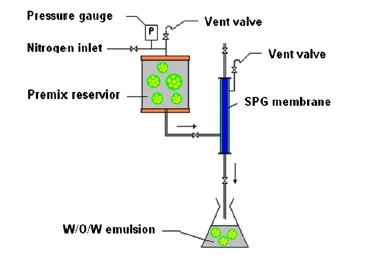
Molecularly imprinted polymersthey (MIPs) have a variety of applications including separation, controlled release, solid-phase extraction and antibodies. But the classical method for preparing MIPs was bulk polymerization. The whole process is tedious and time-consuming, and the resulted particles have low capacity and unfavorable site accessibility to the target. Recent methods including suspension polymerization and precipitation polymerization are still hard to get the desirable imprinted microspheres.
Researchers with Institute of Process Engineering (IPE) prepared the MIPs by premix membrane emulsification technique. In their work the feasibility of synthesizing relatively uniform MIPs nanospheres was demonstrated on the example of chloramphenicol (CAP) using methacrylic acid (MAA) as functional monomer and ethylene glycol dimethacrylate (EDMA) as cross-linker.
The synthesis process was as follows: CAP, MAA, EDMA and the initiator AIBN were dissolved in porogen solvent ethyl acetate as oil phase. Then they were saturated with dry nitrogen and added into water solution which contained a proportion of PVA. The coarse emulsions were extruded through the uniform pores of the Shirasu Porous Glass(SPG) membrane to obtain uniform smaller droplets (Fig. 1). The obtained nanospheres were collected by centrifugation and washed respectively with hot water and methanol/ acetic acid solution until no template molecule can be detected by spectrophotometer. Finally, they were washed with methanol and water, and then dried in a vacuum drier.
In their work, the operating factors such as transmembrane pressure, number of transmembrane cycles and volume ratio of oil–water phase were optimized in terms of their influence on emulsion properties. When the membrane pore size was 1.4 mu m, transmembrane pressure was 2.00 MPa, transmembrane numbers were 5 times and the volume ratios of oil-water in the coarse emulsions was 1:20, the resulted nanospheres were relatively uniform and their sizes were between 300-800 nm.
In addition, the imprinting performance of the imprinted nanospheres for CAP was evaluated including selectivity and adsorption capacity. Researchers used a few analytes with similar structure and properties as template molecules to perform the experiments. The results indicated that the imprinted nanospheres had good selectivity. Adsorption kinetics and adsorption isotherm of the imprinted nanospheres exhibited that the adsorption equilibrium time was around 60 min and the maximum theoretical static binding capacity was up to 158.78 mg g(-1).
The authors greatly appreciate the support of the National Natural Science Foundation of China, Beijing Natural Science Foundation and Engineering Research Center of Biomass Materials (SWUST) of Chinese Ministry of Education.
The paper was published in Journal of Membrane Science.

Fig.1. Schematic diagram of miniature kit for premix membrane emulsification. (Image by IPE)

86-10-68597521 (day)
86-10-68597289 (night)

52 Sanlihe Rd., Xicheng District,
Beijing, China (100864)

